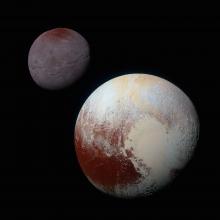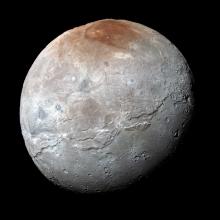Listen to today's episode of StarDate on the web the same day it airs in high-quality streaming audio without any extra ads or announcements. Choose a $8 one-month pass, or listen every day for a year for just $30.
You are here
Moon and Pluto
Pluto isn’t an easy target for skywatching. It’s so small, remote, and faint that it’s visible only through a good-sized telescope. Today, though, you can get a good idea of its location in the sky because the Moon will pass quite close to it. In fact, as seen from some parts of the globe, the Moon will pass in front of Pluto, briefly blocking it from view.
Pluto is a fascinating world. Although it’s only about two-thirds the diameter of the Moon, it has a dynamic surface. Massive glaciers flow around ice mountains, and a possible volcano may belch ice. And Pluto has a thin atmosphere that supports thin clouds.
Some of the nitrogen from Pluto’s atmosphere may have escaped and coated the north polar region of Pluto’s largest moon, Charon, giving it a red “beanie cap.” Charon and Pluto’s four smaller moons probably formed when Pluto was smacked by another large body, blasting debris into space.
Pluto is passing through Sagittarius, which crosses the daytime sky at this time of year. And today, the crescent Moon is there, too.
The Moon will climb into good view in the southeast in early afternoon. It’s so faint, though, that you’ll need to look carefully to find it. For most American skywatchers, Pluto will stand just to the upper right of the Moon as they rise, and a little farther to the lower right of the Moon after night falls. But you’ll need a good telescope to pluck the little world from the starry background.





